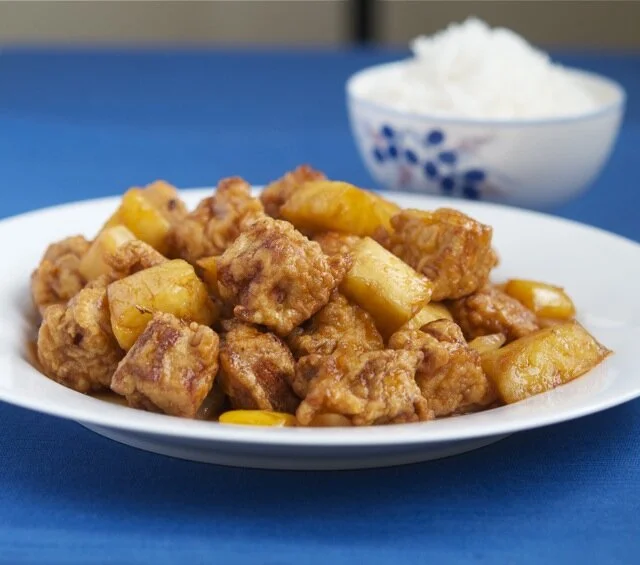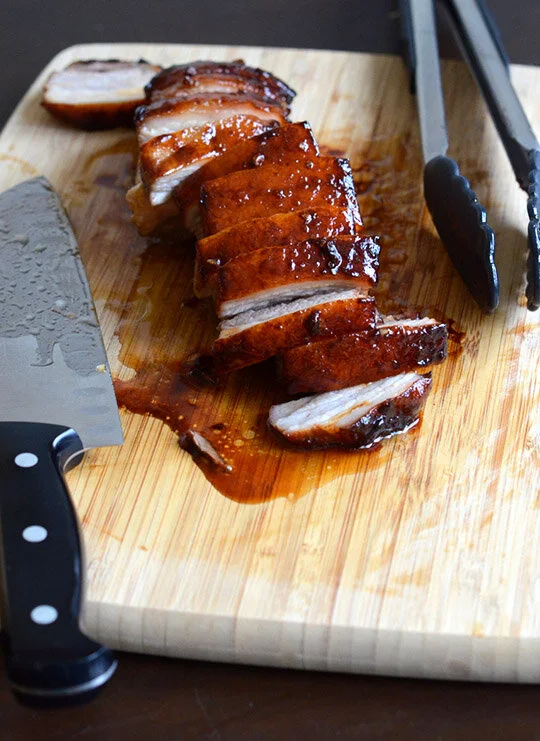These shallot oil noodles look super simple, but words cannot describe how good they are.
Read MoreMapo tofu ramen is a hybrid dish that has become a big part of Japan’s ramen culture.
Read MoreThese simple ribs are coated with a delicious sauce blend: sweetness from the preserves, tartness from the vinegar, earthiness from the hoisin sauce, and lip-smacking savoriness from the soy sauce and pork itself.
Read MoreSweet and sour pork (or “gu ou yuk”) is thought to have originated in Guangdong province.
Read MoreIf I had to make a list of my top favorite comfort foods of all time, mapo tofu would be among the top 10.
Read MoreThis is one of my favorite Sichuan dishes of all time, with a deliciously spicy sauce that is positively addictive.
Read MoreFor the fourth video in my Chinese cooking video series, I decided to make a family recipe that's also one of the most popular in my new book The Chinese Takeout Cookbook. It's a quick fun video set to American folksy music, a nod to the Chinese cooking culture here in the U.S. dating from the late 19th and early 20th centuries. Enjoy!
Along with wonton noodle soup, char siu (Chinese barbecued pork or Chinese roast pork) is the Cantonese people's greatest contribution to mankind. Really, who can resist slices of half-fatty, half-lean roast pork, crisp and dripping with caramelized juices? (I first posted this recipe for Chinese Barbecued Pork back in February 2009 and it became an instant hit.)
You know those enticing pieces of pork dangling in Chinatown restaurant windows? When you get char siu at a Cantonese restaurant, it will most likely be red from a little food dye, used to attract customers. A small amount of dye isn't harmful (think of all those M&Ms and Skittles you've eaten). But sometimes a restaurant will go overboard. My mother still has nightmares of glowing magenta char siu from Boston's Chinatown.
Read MoreKnown as "gua bao" in Taiwan, these buns feature pork belly that has been braised in an aromatic mixture of soy sauce, rice wine, homemade stock, cinnamon, star anise, chilies, and Sichuan pepper.
Read MoreAlong with butter, ketchup, and chili sauce, one of the key items I have in my fridge at all times is a jar of kimchi. This addiction started a few years ago. I had been a casual fan for a while, eating it periodically in Korean restaurants. But after a one-week trip to Seoul in 2008, where kimchi and an assortment of other banchan (side dishes) are given to you with every restaurant entree, I became hooked.
Since then, other than during periods of moving and lengthy traveling, a jar of kimchi has been a kitchen staple. I top off noodle dishes with it. Serve it on the side with Korean braised short ribs and other beef dishes. Top off fried eggs with it. Or just eat it straight from the jar as a (very healthy!) snack.
Another favorite dish I like to use kimchi in is a stir-fry with pork belly or thickly-cut bacon. (My version is very similar to the Korean buta kimchi but uses regular chili sauce instead of gochujang, or sweetened Korean chili sauce.) To make it, you simply stir-fry the pork until it's nice and crispy, then cook the onions, garlic, scallions, and kimchi before adding the spicy sesame-scented sauce. It's easy to prepare but will look very impressive when you set it on the dinner table. It also tastes incredible, like the pork, kimchi, and sauce were just meant to go together.
Since we're now officially deep into winter, I'd like to re-share a recipe for Japanese pork belly, or buta no kakuni. Really, there are few things that are better on a cold day than a bubbling pot of braised pork belly and its aroma of of ginger, scallions, star anise, and sweetened soy sauce altogether. And because we're still in the midst of the holiday season, you have an excuse to indulge. Here is a revised version of the recipe, first published in April 2010.
At a dinner party earlier this week, a nutritionist from China told me point-blank the main problem with American diets is the overwhelming meat consumption. Meat was a bigger culprit than carbs or complex sugars, he said. Americans think nothing of eating a 22 oz. steak or a bucket of fried chicken in a single meal, with potato as a "vegetable" side. There's not moderation in this country, and that's why obesity is such a huge problem. I nodded and agreed, mentioning, among other things, the now notorious Double Down.
The next night, without thinking, I made a pound of pork belly for dinner.
Read MoreDan dan noodles is one of those quintessential Sichuan dishes that you must try at least once if you're a fan of anything spicy. The chili-laced vinegar and sesame sauce is quite possibly one of the finest sauces that ground pork or beef can ever be cooked with.
Now, if you were to have dan dan noodles in Sichuan province, the noodles would come swimming in a chili-laced broth that is almost impossible for mortals (non-Sichuan-natives) to slurp. I like to do a less saucy version that tones the heat down slightly while still maintaining flavor. The noodles in this recipe are spicy enough for someone who doesn't mind a little heat in their food. But please feel free to adjust the amount of chili oil to your preferences. And slurping is, of course, encouraged.
The first time I ever had dan dan mian was years ago in New York's East Village. It was one of those insanely hot and muggy July days, and my friend Shar and I were walking on St. Mark's Place, sweaty even in tank tops and skirts.
"Where do you want to have lunch?," I asked.
"Anywhere with AC," was the reply.
Read MoreIt's hard to believe that when I first made Vietnamese Caramelized Pork almost four years ago in China, I had the hardest time finding fish sauce. Beijing locals know what they like to cook at home, and it's not Cantonese or Southeast Asian. (Regional culinary borders are much stronger in China than they are here, so even wonton wrappers or thinner dumpling wrappers were available in only a handful of markets.) Luckily, finding fish sauce is much easier to find in my neighborhood in Park Slope, whose fish markets and Korean-run bodegas stock fish sauce now and then. (Being a short subway ride from Sunset Park helps too.)
Here's a revised version of the caramelized pork recipe I first posted on December 28, 2007. Updates include more braising liquid and a longer simmering time for more fork-tender, melty pork. I've remade this over the years with both pork shoulder and pork belly, and both are phenomenal with this caramelized sauce. Give it a try and let me know what you think!
I never thought I would have trouble finding fish sauce in China. Growing up, many of the Cantonese dishes my mother cooked contained fish sauce. In New York's and Boston's Chinatowns, Squid Sauce and other varieties of nam pla were staples in every market.
Read MorePork salad! If these two words make you perk up at your desk, please read on.
[But before I begin, an apology first to anyone who has used the "Contact Me" form in the past couple of months. It had been broken for a while before a vigilant reader got a hold of me through Facebook and I realized this error. (And I've always wondered, when using contact forms myself on other websites over the years, if messages just disappeared into a black hole because of coding errors.) So I got rid of the form, but still want to hear from you guys! From now on, just email me at appetiteforchina (at) gmail (dot) com with any questions or comments.]
Now on to the salad. I first learned how to make larb mu (also spelled laap mu, larb moo, laap moo, etc.) from my friend Sandra, who taught cooking classes with me at the Hutong in Beijing. When we met, she already had already built an impressive globetrotting life, having lived and worked (mostly for NGOs) in Haiti, Vietnam, Taiwan, and mainland China, with Afghanistan soon to follow. In her spare time she made a habit of sniffing out the best local restaurants and street food wherever she was, and developed a ravenous curiosity for ingredients and techniques. Lucky for me, she had also spent a good amount of time traveling in Thailand and Laos, where this salad comes from (it originated in Laos and spread to Northern Thailand). After Sandra taught her Thai cooking class at the Hutong and made 4 pounds' worth of larb mu, I couldn't stop talking about the salad for weeks.
Over the years it's become an standby for whenever I crave Northern Thai food and want it fast.
Read MoreMy bookcase is resembling the Leaning Tower of Pisa. It's not a very sturdy piece of furniture to begin with, and under the weight of all my cookbooks it has begun to lean more and more to the left, about an 1/8 of an inch each day for the past week. There's probably a loose screw in the back. Every time I remove a book or put one back on the shelf, it makes a creak that says "I'm going to topple at any second". Either I buy a new bookcase, stat, or stop purchasing cookbooks.
Buying a new bookcase was the easier option. While I wait for a new bookcase to be delivered (a nice sturdy mahogany one), I've had to momentarily suspend cookbook buying. Unfortunately, because the Brooklyn Public Library does such a good job of stocking up on newish tomes, my piles continue to grow.
Thanks to the library, my favorite cookbook discovery from the past month was actually published in 2008. And it's not Chinese.
Read MoreI can't believe that we are already almost halfway into October. Where did the September go? For that matter, where did the entire summer go? It seemed like only yesterday that I had been busy bookmarking summer concerts and looking forward to beach trips and lazy days in the park, most of which did not materialize. (This summer I did, however, finally discover Arrested Development, and spent a good many 100-degree weekend days with the Netflix instant queue, a powerful fan, and an icy gin & tonic.) Yes, in general, the summer seemed to have flown by.
To be fair, many of my waking hours this summer had been devoted to not only side editing projects but also something pretty big and exciting. So I apologize for having been somewhat absent on the site. But the absence has been for a good reason and I can't wait to share the news with everyone in the coming weeks. And postings will definitely become more frequent again.
Read More







